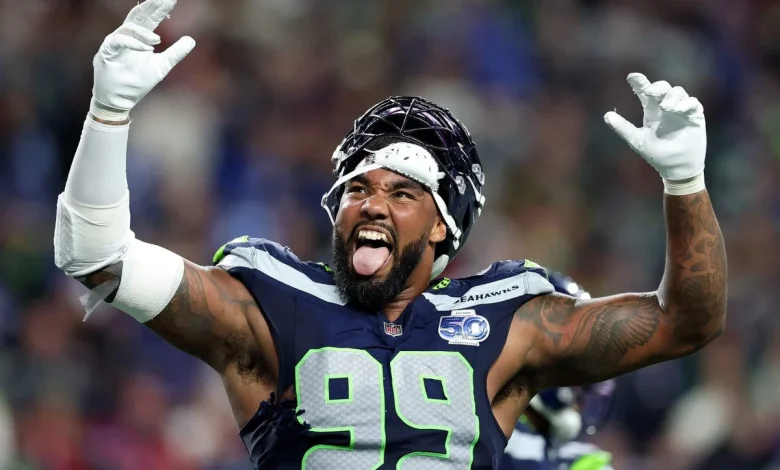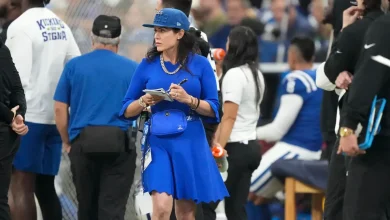Why the Seahawks, fresh off their bye, look like contenders in a wide-open NFC – The Athletic

RENTON, Wash. — This time last year, the Seattle Seahawks were .500, third place in the NFC West and attempting to match the on-field product with first-year head coach Mike Macdonald’s vision.
Now, Macdonald’s Seahawks are much closer to making his dream a reality, and they’re set up to make a run coming out of their Week 8 bye, starting with a road game against the Washington Commanders on Sunday night.
Earlier this week, Macdonald said he’s hyper-focused on his club and doesn’t pay much attention to his team’s position in the conference. “I didn’t sit in front of the TV all Sunday,” Macdonald said of his time management during the bye.
For those who did observe the rest of the league during Seattle’s weekend off, there was an obvious takeaway: In an NFC absent an obvious frontrunner, the Seahawks have as good an argument as anyone to be considered a contender.
At this stage of the season, point differential is just as instructive as record. The Seahawks are 5-2, occupying the fourth seed in the NFC. They have the conference’s third-best point differential (+57) behind the Detroit Lions (+64) and Los Angeles Rams (+58).
Compare that to two years ago, when the Seahawks were 5-2 (third in the NFC) through Week 8 with a +30 point differential, which ranked fifth in the conference. That team lost five of its next six games and missed the playoffs.
The Athletic’s playoff simulator lists Seattle with an 84 percent chance of making the playoffs and a 34 percent chance of winning the NFC West. The Rams (90 percent and 49 percent, respectively) have the best division title odds, while the 49ers (73 and 17) are third behind Seattle. The NFC West is a competitive three-team battle, and the conference as a whole is just as tight.
The Seahawks have their warts, as do the teams above them in the standings. The Green Bay Packers are atop the conference at 5-1-1, but their loss to the Cleveland Browns (they scored only 10 points) and tie with the Dallas Cowboys (they allowed 38 on defense) illustrate that they are susceptible to an off night on either side of the ball. The Philadelphia Eagles (6-2) are finding their groove offensively, but their defense is more vulnerable than last year’s Super Bowl-winning unit. The Tampa Bay Buccaneers (6-2) are regressing offensively as injuries have piled up.
All those teams are dangerous, to be clear. As are the Detroit Lions (5-2) and the Rams (5-2), the second-place teams in their respective divisions. Both offenses rank within the top 11 by points per drive, and both defenses are in the top 10 (all stats provided by TruMedia). Their quarterbacks are playing well, and they have effective rushing attacks. All the top teams in the NFC, 49ers included, are well-coached and have multiple years of playoff experience.
And yet, there’s nothing really separating the Seahawks from any of those teams. That’s true now and will likely be true two months from now, especially with cornerback Devon Witherspoon and edge rusher Derick Hall on track to return this week (safety Julian Love suffered a setback with his hamstring recovery and could be headed for injured reserve, Macdonald said Wednesday).
The Seahawks care less about how they stack up against the rest of the league and more about upholding their own standards. On defense, the goal is to be the best in the league. They are right on track, starting with the facet of the game every defense wants to dominate: the run game.
On running back carries, Seattle has allowed the fewest yards (402) and yards per attempt (3.0). The Seahawks are one of four teams to give up just two rushing touchdowns by tailbacks; only the Rams (zero) have a lower total. The advanced numbers are strong, too. They’re No. 1 in rush EPA, third in explosive rush rate and sixth in success rate. The longest run they’ve allowed to a running back is just 13 yards, tied with the Rams for the lowest in the league.
Some of Seattle’s dropback numbers aren’t as good. However, the Seahawks still rank in the top 10 in opponent passer rating, explosive pass rate, sacks, interceptions and yards per pass attempt, despite not yet having its secondary at full strength. There just aren’t many defenses playing better ball than the Seahawks right now, and there’s not much to suggest that will change. This is what everyone in the building envisioned this offseason when replacing Dre’Mont Jones with DeMarcus Lawrence and using a second-round pick on defensive back Nick Emmanwori.
“We’re upholding (our standard) in the run game,” Lawrence said. “Where we can elevate our game and get better is making those plays when the opportunity presents itself to us: interceptions, forced fumbles. On sacks, we’ve got a good chance of getting the ball off the quarterback, (and) we’ve got to capitalize on those opportunities.”
(To Lawerence’s point, the Seahawks are the only NFL team that hasn’t forced a fumble.)
One of the pleasant surprises through the first eight weeks is the emergence of Josh Jobe as a lockdown outside cornerback. Among corners to play at least 200 coverage snaps, Jobe has allowed the eighth-lowest passer rating, according to Pro Football Focus. Jobe, who re-signed this offseason on a $2 million contract, has done this while regularly lining up opposite the opponent’s best wide receiver, often in press coverage.
Seattle plays a great deal of zone coverage, but in critical situations, Macdonald often trusts his corners to press at the line. Thus far, Macdonald has weaponized Jobe’s ability to stick with the opponent’s top playmaker.
The best receivers in the league are dangerous from multiple alignments, so Jobe won’t be asked to shadow the WR1. But in many gotta-have-it moments, the difference between success and failure is whether cornerbacks can win their one-on-one matchups. That’ll be important in the second half of the season as Seattle faces stud pass catchers such as Puka Nacua and Davante Adams (twice), Justin Jefferson and Jordan Addison, Drake London, Michael Pittman Jr. and rookie Tetairoa McMillan (and whoever is WR1 for the 49ers by Week 18).
“We want to be able to press as much as possible, and when you can do that, it helps how you operate,” Macdonald said. “Some teams play great ball playing off and letting routes distribute — that’s not really our philosophy. (Jobe) is able to make that come to life.”
Seattle’s offense ranks 13th in points per drive and 16th in EPA per play. Sam Darnold is eighth among qualifying quarterbacks in dropback EPA. He has the seventh-lowest sack rate, a testament to his decision-making and the play of the offensive line. Despite being idle in Week 8, Jaxon Smith-Njigba is still the NFL’s leading receiver, with a 99-yard gap between him and second place (Ja’Marr Chase, 720).
There are really only two blemishes on the Seahawks’ resume, and they’re connected: They struggle to run well enough to put teams away in the second half, and their third-down conversion rate is the fourth-worst in the league (tied with the Eagles and Vikings). Seattle averages the fourth-longest distance to gain on third down (7.7); only the Jaguars, Eagles and Bears are worse.
Macdonald said “we’re not there” when asked about his third-down offense. The Seahawks convert on third-and-short and third-and-medium at above-average rates — and they’re top five in the latter category — so fixing the issue starts with avoiding third-and-long, which is in part tied to their inconsistent run game.
“We’ve got to scheme a little bit better, execute a little bit better, protect a little bit better,” Macdonald said. “Once we start doing that, then we’ll get better returns.”
Rookie fullback Robbie Ouzts returned to practice this week and might play Sunday night against Washington. Seattle’s run game is meant to operate with a fullback, and although Brady Russell played well against Houston, Ouzts’ return should give the unit a boost. If it does, Seattle will only strengthen its contender case during this second-half stretch.
“I’m excited about where we are,” Macdonald said, “and where we can go.”





